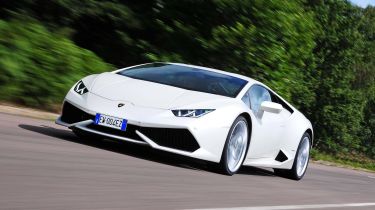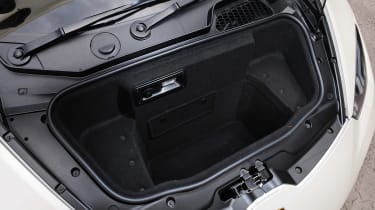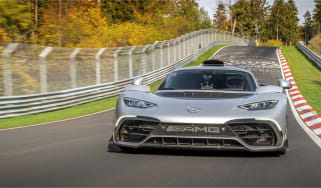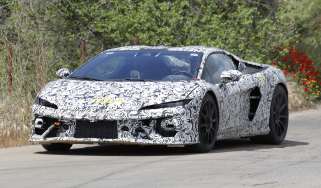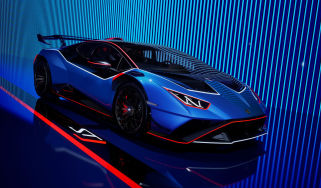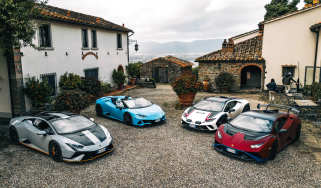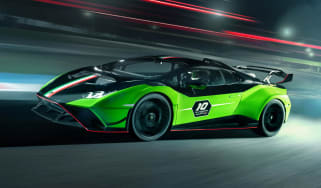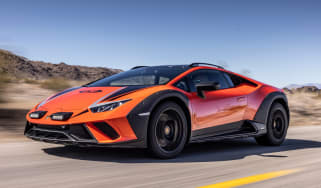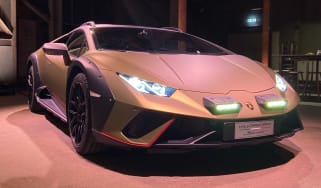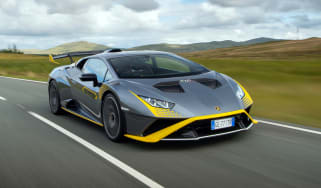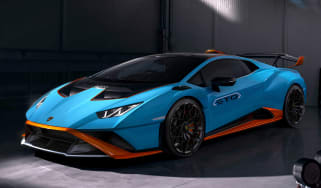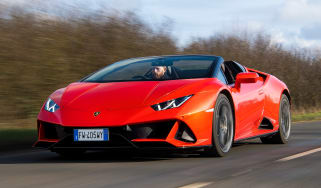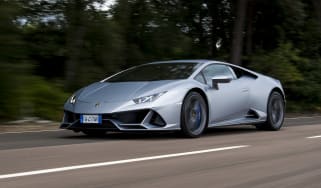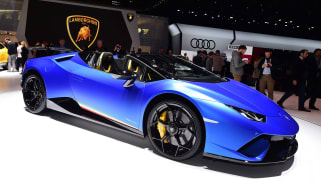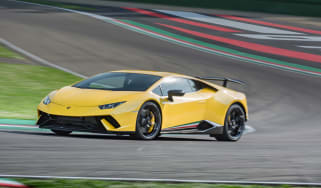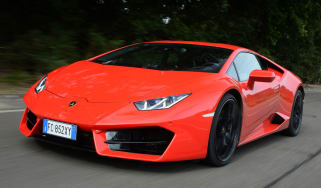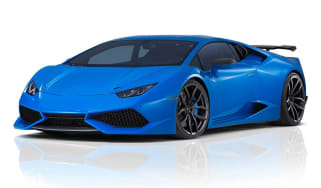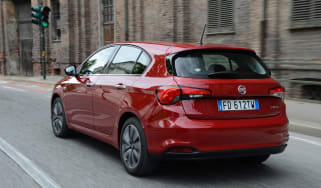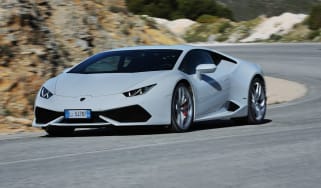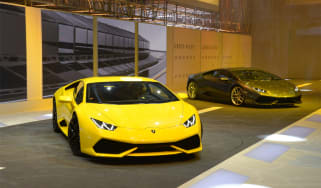Lamborghini Huracan review
The Lamborghini Huracan is a flamboyantly styled supercar with performance that matches its looks

The Lamborghini Huracan might lack the visual theatre of some of the previous models to come out of Sant'Agata – it’s no Countach – but it has the potential to turn heads like any self-respecting supercar.
That it shares much in common with the Audi R8 hardly seems to matter, especially when the beating heart of a 5.2-litre naturally aspirated V10 engine is sat behind the seats. It feels every inch a Lamborghini, even if it’s only the final assembly that takes place at Lamborghini’s factory.
The Lamborghini Huracan LP 610-4 had a pretty tough job on its hands when it launched in 2014, as the successor to the marque’s most popular car ever, the Gallardo.
The Huracan’s predecessor sold over 14,000 copies over its 10-year lifespan, so as you’d expect, the VW Group-owned supercar maker did little to change the basic formula of its replacement. Which means the Huracan is an affordable – well, relatively speaking! – two-passenger mid-engined supercar. A meaty V10 nestles behind the seats, while four-wheel drive offers reassurance and grip on the road for when you unleash the 600bhp+ onto unsuspecting tarmac.
Lamborghini now offers the Huracan in a three-car ‘Evo’ range. If the standard coupe is not enough of a thrill, there are two further configurations - the Huracan Spyder roadster model, and a slightly less-powerful, but more driver-focused two-wheel drive coupe.
Used - available now

2024 Lamborghini
Huracan
3,008 milesAutomaticPetrol5.2L
Cash £199,950
2023 Lamborghini
Huracan
13,979 milesAutomaticPetrol5.2L
Cash £189,990
2024 Lamborghini
Huracan
2,200 milesAutomaticPetrol5.2L
Cash £275,000
2023 Lamborghini
Huracan
25,000 milesAutomaticPetrol5.2L
Cash £159,995All the Huracan engines are normally-aspirated variations on Audi’s 5.2-litre V10, and the model was launched with a brand new aluminium and carbon-fibre chassis. With performance to match its wild looks, even the ‘slowest’ Huracan 0-60mph time is barely over three seconds, while top speed sits at around 202mph, ensuring Lamborghini will rarely be embarrassed in a game of Top Trumps.
The Lamborghini shares much more than its engine with the Audi R8, as most of the chassis and powertrain engineering is carried over, too. It means the R8 must be counted as one of the key Huracan rivals, particularly as it’s a cheaper proposition and offers quattro four-wheel and two-wheel drive. The other rivals for the Huracan are either mid-engined supercars like the McLaren 570S, Honda NSX and Ferrari 488 GTB, or four-wheel drive coupes like the Porsche 911 Turbo, Jaguar F-Type SVR or Nissan GT-R Nismo.
Huracan buyers might also be tempted by luxury front-engined GT cars like the Aston Martin DB11 V12, Mercedes-AMG GT S and Maserati GranTurismo.
Engines, performance and drive
Lamborghini has used the might of the VW Group engineering department to pack the Huracan with the very latest technology. The aluminium and carbon-fibre chassis is 10 percent lighter and 50 percent stiffer than the Gallardo’s, while adaptive damping is available as an option and the electromechanical steering varies its ratio depending on your speed.
The electronically-controlled four-wheel-drive system sends 70 percent of power to the rear in normal operation, but can divert up to 100 per cent to the rear if it senses slip at the front. Plus, there’s a new Lamborghini Dynamic Vehicle Integration (LDVI) function, which is basically the technological brain of the EVO, capable of coordinating the driving dynamics based on the driver's input, external environment and the selected driving mode.
Three increasingly aggressive driving modes are selectable via an ANIMA switch on the steering wheel and, perhaps most significantly, the old automated manual box has been ditched in favour of a lightning-fast and perfectly smooth seven-speed twin-clutch transmission - the same as the one found in the Audi R8.
The steering is light and incredibly precise, while the standard carbon-ceramic brakes provide immense stopping power, even after several flying laps on a track.
Push the Huracan to the limits of adhesion, and even in its most aggressive Corsa mode it tends to understeer rather than let the back step out for heroic smoky drifts. It just doesn't feel that adjustable on the limit – in this respect both the Ferrari 488 GTB and McLaren 650S are better.
The rear-wheel drive version is a sweeter handling car than the 4WD model, with more alert responses and greater drivability, thanks in part to a 30kg weight saving.
On the road, the Huracan makes much more sense. With the gearbox in auto and the suspension in its softest setting, it’s more compliant than the Gallardo ever was, and easier to drive day-to-day than any of its rivals. We'd avoid the optional LDS variable-ratio steering system, though; it adds a hint of unpredictability to the Huracan's handling. The standard steering feels cleaner and more precise in its responses.
Engines
The 5.2-litre Audi-sourced V10 now produces 631bhp and 600Nm of torque. It delivers incredible acceleration, along with a deep, growling soundtrack. It takes the Coupe from 0-62mph in 2.9 seconds and on to a 202mph top speed. The Spyder version completes the sprint in 3.1 seconds, with the same maximum.
The rear-wheel-drive Huracan features a slightly detuned version of the same engine, making 601bhp and 560Nm. As a result, and with power only going to the rear wheels, it trails slightly on performance, with a claimed 0-62mph time of 3.3 seconds.
MPG, CO2 and Running Costs
Finding at least £160,000 to buy a Huracan is just the start; as with any supercar, it won’t be cheap to run. Fuel consumption and CO2 emissions for the all-wheel drive Coupe are a claimed 20.6mpg and 332g/km – but with such immense performance at your disposal, you can expect to achieve far less than that in the real world. Specify the heavier Spyder model, and you officially lose nearly half a mile per gallon.
If you decide to go for the rear-wheel-drive model, you’ll see roughly the same fuel economy as the all-wheel-drive variant, with CO2 slightly less at 330g/km.
In case you have a very indulgent boss – or more likely own the company – business users choosing the Huracan will be looking at a 35 percent Benefit in Kind charge based on the purchase price, which translates to monthly tax payments of a little over £2,100.
It’s not just the day-to-day running costs that will look steep; wear and tear items are expensive, too. Carbon-ceramic brakes will wear at a slower rate than steel discs, but burn through a set of tyres and four new Pirelli P-Zeros will set you back well over £1,000, while major engine and transmission rebuilds outside of the warranty will run into tens of thousands of pounds. However, nobody said owning a supercar would ever be cheap.
Insurance groups
Not surprisingly, the Lamborghini Huracan sits in insurance group 50 – the highest group possible – no matter which version you go for.
Depreciation
All supercars tend to enjoy a depreciation ‘honeymoon period’ when they’re brand new and in short supply, while rare and limited-production models can even increase in value over time. Sadly, in supercar terms the Huracan is a high-volume model, and as a result you can expect to lose a massive chunk of its purchase price over a three-year ownership period.
Predictions suggest a Huracan Spyder that costs over £200,000 to buy new, is likely to lose a massive £110,000 over three years. The rear-wheel-drive version is expected to perform a little better, depreciating by around £82,000.
Interior, design and technology
The Huracan isn’t one of Lamborghini’s most outlandish shapes, but it’s a beautiful piece of design nonetheless. The wedge-like profile continues where the Gallardo left off, while the front end gets an extra dose of aggression with a full-width lower grille and slim horizontal headlights.
At the rear, four exhausts at the outer edges emphasise the car’s width, while an intricate honeycomb grille mesh picks up on a hexagonal theme that runs throughout the car. The extrovert shape isn’t just for showing off, either; the Huracan produces 50 per cent more downforce than the Gallardo without resorting to using a big rear wing or jutting chin spoiler.
Drop into the low, firm sports seats and there’s excellent forward visibility, but you’ll need to order the optional transparent engine cover to see anything out of the back. Most of the controls, including the headlight and indicator switches, have been moved to the steering wheel, while the 12.3-inch Virtual Cockpit made its debut on the Huracan, before it was officially revealed as part of Audi's technology line-up. The screen replaces conventional dials, and can be configured in a variety of ways to show your speed and revs, as well as sat-nav and audio information.
Build quality sets new standards in the supercar class, while Lamborghini continues the aeronautical theme from the Aventador with a fighter jet-style flick-up cover for the ignition button.
It's not all good news, though; the indicators are controlled by a tiny switch on the steering wheel which is difficult to operate, and it's a similar story with the windscreen wipers.
Sat-nav, stereo and infotainment
The Huracan Evo gets a heavily revised interior with uprated infotainment, including an 8.3-inch touch screen on the centre console that can be used to control a multitude of functions including the car’s set-up via the LDVI system. However, Lamborghini doesn’t supply all the features you might expect as standard for the price.
Equipment that’s included in a high-spec Ford family car costs extra in the Huracan – parking sensors, a reversing camera and sat-nav all have to specified from the options list. Even Bluetooth phone connectivity and DAB radio cost extra.
One fun option is the Lamborghini Track and Play app, which links to an on-board camera and turns your smartphone into a telemetry centre, so you can record and analyse your track day heroics.
Practicality, comfort and boot space
Clearly, the two-seat Huracan hasn’t been designed with practicality as a priority, but it’s not quite as hopeless in this respect as you might think. As well as a small ‘boot’ under the bonnet, it offers 60 to 70 litres of space behind the seats (depending on how far back you push them), while the floating centre console design has freed up a useful cubby behind that’s hidden from view.
There’s also a decent driving position – although taller owners may struggle for leg and headroom – and the seats are supportive, if sparsely padded.
Whereas an Aventador feels too large and loud around town, the Huracan really could be used as an everyday commuter car, as it offers good visibility, light steering and a silky-smooth gearbox. Plus, the all-weather grip provided by the four-wheel-drive system and the decent ride comfort ensure long motorway journeys aren’t a chore.
Dimensions and size
It’s a large car by family hatchback standards, but when parked next to its Lamborghini Aventador sister model, the Huracan is relatively compact. It’s 4,459mm long, 1,924mm wide and 1,165mm tall; in comparison, the Aventador is longer and wider, at 4,835mm by 2,030mm, although it’s not as tall, at 1,136mm.
The Huracan’s chief rival is the Ferrari 488 GTB, which is also slightly larger, measuring 4,568mm tall, 1,952mm wide and 1,213mm tall.
Leg room, head room & passenger space
The driving position is reasonable for averaged-sized individuals, and the steering wheel adjusts for height and reach. But tall drivers will suffer from a shortage of leg and headroom, while the seat height – set at a level that allows decent forward visibility over the bonnet – means it’s quite hard to see upwards to traffic lights, for example, as the roof gets in the way. That said, there’s a full range of seat movement, and electric adjustment is an optional extra, too.
Boot space
With its engine where the boot ought to be, there’s not a great deal of space for luggage in a Huracan. But push a button in the passenger footwell, and the bonnet pops up at the front of the car to reveal a surprisingly generous storage area. It offers 150 litres of space, so you won’t be fitting your golf clubs in there, but a couple of soft weekend bags will squeeze in without a problem.
Reliability and Safety
Although the Huracan’s 5.2-litre V10 has been thoroughly reworked, it has effectively already had 10 years of service in the Gallardo. During that time, customers raised no major complaints.
There are a few things to keep your eye out for, though: overfilling with oil or using cheaper alternatives to the manufacturer’s recommended lubricants have both been known to cause engine failure.
The electric architecture is taken from the VW Group parts bin and dressed with Lamborghini branding, which means it’s proven, robust and bang up to date. The build quality, too, is second to none, so if treated with care, a Huracan should age well on its way to becoming a classic. But if you plan to drive your car hard or take it on frequent track days, the tyres and brakes will inevitably suffer.
Euro NCAP’s independent crash testing doesn’t extend to exotic models like the Lamborghini, so we have to rely on manufacturer information for insights into how such cars perform if the worst happens.
There’s always an element of risk when getting behind the wheel of a supercar and driving it briskly. But the Huracan is arguably one of the safest and most accessible choices in its class, thanks to its combination of four-wheel-drive traction and its inclination to understeer rather than spin out of corners backwards.
The car’s construction is pretty cutting-edge, with an aluminium and carbon-fibre core that’s said to be 50 per cent stiffer than its predecessor the Gallardo.
As you’d expect, the Huracan comes with a full complement of airbags, plus stability and traction control. There’s nothing on offer in the way of more advanced driver aids like adaptive cruise control, lane assist or city brake assist, but perhaps that’s not wholly surprising in such a driver-focused car.
Warranty
Lamborghini supplies its cars with one of the most generous warranties in the VW Group. Perhaps the brand has the biggest hill to climb in terms of reputation thanks to some horrendous tales about unreliability from its days before the Volkswagen takeover, but the four-year/unlimited-mileage package provides impressive peace of mind.
Servicing
It’s recommended that the Lamborghini Huracan is serviced every 12 months or 9,000 miles. Main dealers offer fixed prices for annual maintenance, and you can expect to pay somewhere in the region of £950 to £1,100 for a check.

